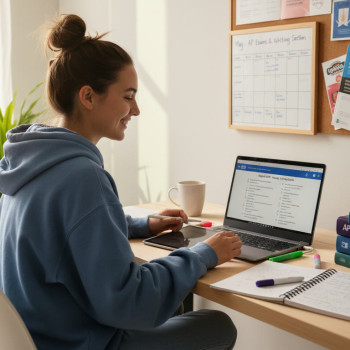Why digital tools are a game-changer for SAT prep
Remember when SAT prep meant stacks of paper practice tests, highlighter-cramped passages, and a kitchen timer that never cooperated? Those tools taught grit—but today’s students have access to a different kind of advantage: digital tools that help you practice smarter, not just harder. These tools speed up feedback, let you simulate the actual Digital SAT environment, and—most importantly—help you build repeatable, sustainable study habits.
This article is written for students who want more than last-minute cramming. You’ll get practical ways to use apps, testing platforms, timers, note-taking tools, and tutoring to create a study routine that sticks. You’ll also see examples, a sample weekly plan you can copy and customize, and a compact comparison table so you can choose the right mix for your needs.
Start with a clear, realistic goal
Any effective habit begins with a clear goal. Vague aims like “do better on the SAT” are hard to act on. Instead, define a specific target and timeline: a target section score, a target test date, and the number of hours per week you can consistently commit. Your digital tools will work best when they have a goal to measure progress against.
How to pick a target
- Look up the median SAT scores of the colleges you’re interested in and set a realistic stretch goal above that.
- If you already have a practice test score, add 50–150 points for a moderate improvement target over 3–4 months, depending on how much time you can study weekly.
- Choose small interim targets: weekly practice goals, section-by-section milestones, and a dress-rehearsal test date two weeks before your real test.
Choose a few digital tools—and stick with them
It’s tempting to try every app and extension. Resist. Habit formation depends on consistency, and switching tools constantly interrupts momentum. Pick a core set of 3–5 tools that cover the essentials: full-length practice tests in a realistic environment, topic practice and drills, progress tracking, time management, and targeted help when you’re stuck.
Recommended tool types and how to use them
- Official Digital Practice Platform (full-length tests): Use a Bluebook-like test app to take timed, adaptive practice tests. Simulate test day conditions—device, headphones, breaks—and treat one practice test like a real exam every 2–3 weeks.
- Personalized practice engine: A platform that adapts practice problems to your strengths and weaknesses is invaluable. Use it for focused skill work (e.g., algebraic manipulation, command of evidence, grammar rules).
- Note-taking and flashcard tools: Digital flashcards and a searchable notes app help you convert mistakes into high-yield review items.
- Calendar and habit trackers: Schedule study blocks and log completed work. Seeing streaks keeps motivation high.
- Targeted guidance: When self-study stalls, 1-on-1 tutoring with personalized plans and expert feedback can break plateaus. Tutoring that blends human coaches with AI-driven insights gives the best of both worlds: empathy, strategy, and data-backed adjustments.
Turn practice tests into feedback-rich learning events
A full-length digital practice test is not just a score; it’s a diagnostic goldmine. Use the test to find patterns and then structure the next 1–2 weeks of study around those patterns. A single practice test can power multiple targeted study sessions if you analyze it correctly.
How to analyze a practice test (step-by-step)
- Score the test and record section and question-type results immediately.
- Classify every missed question by error type: careless mistake, concept gap, misread, timing issue, or unfamiliar format.
- Create a short review plan: 3–5 focused sessions addressing the most frequent error types, then a mixed-practice session to ensure transfer.
- Turn repeat mistakes into flashcards or problem templates in your notes app so you can drill similar items later.
Build micro-habits that compound
Big study sessions are important, but habits are built on small, consistent actions. Digital tools shine at nudging you to do micro-practices: 15-minute targeted drills, two vocab flashcards while waiting for a bus, or a 10-minute review of last week’s error list before bed.
Simple micro-habit examples
- Daily: 15 minutes of math drills in the morning app session.
- Every other day: 20-minute reading passage practice with annotation focus.
- Weekly: One full timed practice test; one review day to convert mistakes into study items.
Use data—don’t be ruled by it
Digital tools give you numbers. That’s a gift—and a trap. Track performance metrics (accuracy by question type, time per question, progress toward target score), but remember those numbers are signals, not verdicts. The job is to translate signals into action.
Key metrics to track and what they tell you
| Metric | What it measures | How to act on it |
|---|---|---|
| Section accuracy | Overall mastery in Reading/Writing or Math | Prioritize the weaker section for targeted sessions; swap in timed practice blocks. |
| Question-type accuracy (e.g., algebra, function, command of evidence) | Specific content gaps | Build microlessons and focus drills on those content areas. |
| Time per question | Speed and pacing | Practice pacing drills and learn to triage questions you should skip and return to. |
| Streaks and consistency | Study habit sustainability | If streaks dip, simplify the plan—shorter, more consistent sessions beat infrequent marathons. |
Design a weekly study plan that fits your life
Consistency beats intensity. A balanced weekly plan keeps motivation high and reduces burnout. Below is a sample 6-day plan (with one rest day) you can adapt to the time you have. The idea is to vary intensity, alternate focused practice with light review, and always end the week with a short reflection.
Sample weekly plan (for 8–12 hours/week)
- Monday — Focused Math Practice (90 minutes): targeted drills on two weak subtopics, 20 minutes of timed problem sets, 10-minute review notes.
- Tuesday — Reading & Writing (75 minutes): two passages with close annotation, 30 minutes of grammar drills, 10-minute error log updates.
- Wednesday — Micro-practice (30–45 minutes): 15-minute flashcards; 20-minute timed section on official practice app.
- Thursday — Mixed Practice & Strategy (90 minutes): half practice section in official app, half strategy review (e.g., process of elimination, passage mapping).
- Friday — Light Review (45 minutes): revisit error cards, correct mistakes, and summarize 3 learning takeaways from the week.
- Saturday — Full-length Practice Test or Practice Section (3–4 hours): simulate test-day conditions; follow with a quick debrief at the end of the day.
- Sunday — Rest or optional light review (0–30 minutes): let your brain consolidate. If you must study, do something low-stress like reading articles or reviewing vocabulary.
Turn mistakes into a study system
The most valuable part of digital practice is repeatable review. Instead of flipping past mistakes, build a system that makes them hard to forget.
How to build a simple “mistake loop”
- Immediately tag each missed question with an error type and add a 1–2 sentence note explaining the mistake.
- Create a digital flashcard or searchable note with the problem’s core concept and a shortcut to the rule or explanation.
- Schedule a short targeted review of those items two days later, then again one week later. Spaced repetition works.
Use focused features of the official digital test environment
Practice in the same environment where you’ll take the real exam. Digital test apps have built-in features—drag-and-drop, annotation tools, highlighting, and screen accommodations—that you can use strategically on test day. Familiarity reduces friction and frees up mental energy for the content itself.
Practice tips for the testing app
- Practice using the on-screen tools so you don’t waste minutes learning them during the real exam.
- Try both strategies—annotating aggressively vs. minimalist notes—to see which preserves speed and comprehension.
- If you use a personal device or have an approved accommodation, test the exact configuration well in advance.
Make tech work for focus—minimize distraction
Using digital tools doesn’t mean constant notifications. Learn to use focus features and create a distraction-free study environment. Turn on do-not-disturb, use single-task browser profiles, or a dedicated study account on your device to limit temptation.
Practical anti-distraction strategies
- Use a website blocker for social apps during scheduled sessions.
- Keep a “quick-check” buffer: allow a 5-minute break every 25–30 minutes to glance at messages, then return to study.
- Schedule your hardest work for your peak energy windows (for many students, that’s mid-morning or early evening).
When to bring in a human: tutoring and guided practice
Self-study with digital tools can get you far—but sometimes you need a coach to get unstuck. Personalized tutoring can accelerate progress by diagnosing subtle errors in problem approach, refining test strategy, and building a study plan tailored to your exact timeline and learning style.
If you decide to work with a tutor, look for someone who blends expert instruction with data from your practice: they should review your digital practice tests, adjust your plan based on performance metrics, and give you targeted drills. For students who want both human coaching and AI-driven personalization, a tutoring program that integrates one-on-one guidance with analytics gives you the best support. Sparkl’s personalized tutoring, for example, offers tailored study plans, expert tutors, and AI-driven insights to keep your plan focused and evolving as you improve.
Keep motivation alive with small wins and rituals
Motivation dips—especially during long study stretches. Use small wins and rituals to keep momentum. Celebrate a streak, reward a successful practice test with a favorite meal, or anchor study sessions to a ritual like making a study playlist or brewing a special tea before you begin.
Rituals that boost focus
- Begin each study block with a 1-minute review of your week’s top three priorities.
- Use the same playlist or ambient sound to cue your brain: when the music plays, it’s study time.
- End sessions by logging one short note: what you learned and what you’ll do next. That tiny reflection matters.
Examples: Two real-world student scenarios
Here are two short, realistic examples of how students used digital tools to change their preparation.
Case 1: Maya — balance and incremental gains
Maya had busy after-school commitments and could only study 6 hours a week. She used a digital practice app to take a diagnostic test, identified a consistent weakness in evidence-based reading, and scheduled three 25-minute focused sessions per week on that skill. She used a note app to build a mini-rulebook for passage mapping. After 10 weeks she had more confidence and a 90-point improvement on her practice test because she turned repeated weakness into targeted micro-practice.
Case 2: Jordan — breaking a plateau with tutoring
Jordan had plateaued after months of solo practice. He connected with a tutor who reviewed his digital practice logs, found a pattern of timing mismanagement on medium-difficulty math questions, and introduced pacing drills and strategic skipping. With two live sessions per week to refine strategies and a tailored practice plan, Jordan improved his pacing and gained clarity on when to skip and return—netting a significant score jump in two months.
Checklist before test day: a digital dry run
Run a full dry run on your exact device and environment two weeks before test day. Treat it like a dress rehearsal: install and test the exam app, connect chargers and headphones, simulate breaks, and confirm any accommodations. If you’ve practiced this way repeatedly, test day surprises are eliminated.
Pre-test digital checklist
- Install and update the testing app on your device.
- Charge your device and have a charger ready at the test center if allowed.
- Run through a timed practice test with the same break structure you’ll have on exam day.
- Confirm any accessibility tools or accommodations and practice with them enabled.
- Pack an analog backup (notebook and pencils) if your test policy requires or recommends them for notes during rest-of-day practice.
Final thoughts: make the tools serve the habit, not the other way around
Digital tools are powerful—but they don’t create habits by themselves. Start with a clear goal, pick a small set of tools, and design a routine you can sustain. Use diagnostic practice tests to guide the work, convert mistakes into study systems, and bring in personalized tutoring when you need targeted acceleration. Over time, those small choices compound: 15 focused minutes a day, repeated for months, produces measurable improvement.
Above all, keep your study process kind to yourself. Progress rarely looks linear; expect plateaus and plan for them. When you combine consistent, small actions with the right digital supports—realistic practice tests, adaptive drills, clear note systems, and occasional expert coaching—you’ll arrive at test day calmer, more confident, and better prepared to show what you know.
If you want, I can help you transform the sample weekly plan above into a personalized schedule based on your available time, target score, and test date. We can also map which digital tools pair best with your learning style and how to integrate occasional tutoring sessions for maximum impact.












No Comments
Leave a comment Cancel